Search
Gallery
| Anadol: 55 years old and still on roads... |
|
Mr. Vehbi Koc, Turkish businessman and industrialist, had a dream to manufacture a domectic car in Turkey. In 1928, he was a Ford dealer in Ankara. After the World War II, he was dealing with Italian Fiat to produce tractor in Turkey. In 1959, he was manufacturing Ford trucks in Otosan. In 1960, Otosan started to manufacture Ford Thames trucks and Ford Consul cars in its assembly line. In 1961, Ford Thames Trader minibus assembly line has been added to the production; and 240 Ford Taunus 17M estate cars have been produced within 1963-1965. And it was the right time for a national car. In 1966, Turkey’s car park was 91.000 and yearly car sales were between 2.000 and 3.000 level. Koc went to US to meet with the upper management of Ford Motor Company. They were very reluctant and advised him to continue to the importation of the cars instead of local production which was not feasible due to the poor economical conditions and buying power level of Turkish people. Koc was not convinced by these advises. However, he was very well aware about the automotive investment. In 1966, Turkey’s car park was 91.000 and yearly car sales were between 2.000 and 3.000 level. Koc went to US to meet with the upper management of Ford Motor Company. They were very reluctant and advised him to continue to the importation of the cars instead of local production which was not feasible due to the poor economical conditions and buying power level of Turkish people. Koc was not convinced by these advises. However, he was very well aware about the automotive investment. A production of 23.000 cars per year was not satisfactory for investment costing $50-60 million only for masters. $4.000 amortization per car was very high and at that price, one could buy a modest car. Koc was searching for other alternatives.
Please click this line about the video of Reliant, models and production technology.
Both companies agreed on the idea of producing a fiber glass body car in Turkey. However, Koc was aware about the long and boring legal procedures. First attempt was rejected by the authorities of the government. Fibre glass was a new material and it was not commonly used in automotive sector. Fortunately, Ford changed the cabin style of the Ford trucks manufactured by Otosan. This new style was not applicable in easily in Turkey. Another idea came up: reproduce this new cabin from fibre glass. Otosan got the approval of Ford and ordered the prototype of the cabin to Reliant. New cabin was successfully got the approval of the authorities. This development encouraged Koc and restarted the negotiatons with Reliant. A prototype has been ordered to Reliant. It was decided a 2-door fiber body car (only production of 2-door car was technologically possible in late 60’s) with engine, gearbox, transmissions from Ford. Design of the car has been done by Tom Karen from Ogle Design. The consept models were draft drawings of Ford Cortina and Reliant Scimitar Coupé. During this period, the government has changed and new liberals wanted to inspect the prototype. Eventhough the prototype, coded by Reliant as FW5 (four wheeler 5) was not completely ready, the car has departed with two drivers and has traveled in December from UK to Turkey, despite of bad weather conditions in winter time and reached Istanbul in 63 hours. The authorities inspected and tested the car on December 25th 1965. Authorities from Ministry of Industry have confirmed the production and some conditions have been announced: the car should be on the market within 10 months and the selling price should be below 30.000 TL. Legal procedures of the investment started on January 10th 1966 and 1966 was a very though year for Otosan. As projected, on December 19th 1966, first Anadol came out of the production line. The selling price was 26.800 TL and that was equal to $ 2.980. Powered by 1.2L Ford Kent engine of Anglia, first year 1760 examples of 2-door Anadol (A1) have been produced. Following years, the production reached 12.000 (in 1976) cars per year together with 5.000 pick-up version. In 1971, 4-door Anadol (A2) has been introduced. In August 1968, 1.2L Ford engine has been replaced by more powerful 1.3L Ford Kent engine. On the other hand, Otosan R&D department was working on new models with the leadership of Jan Nahum, son of Bernard Other models were STC-16 (sport car), Anadol SV1600 (estate car) in 1973 and Bocek (bug) in 1975. STC-16 and Bocek were unlucky projects, due to the world economic conjuncture at that period. Production life has lasted shortly. At the end of 70’s, Otosan, with R&D department, headed by Jan Nahum, was chasing the new trends. A small family car, Cagdas prototype, has been designed at that period and this studies have been crowned by academy award in Turkey. At the same period, his brother Claude Nahum and his team developed a 107 HP In 1977, Marcello Gandini of Bertone designed the FW 11 for Anadol and Reliant. 4 prototypes have been produced. Neither Otosan, nor Reliant had given a chance for this model. Later, Citroen purchased this project and with some small changes produced his ever “best seller” model BX, which stayed on line for 12 years. Another Bertone design A9 couldn’t get an approval for production. Otosan, launched A8 16 model in 1981. A8 was the sedan version of estate SV-1600 with some distinctive, contemporary and futuristic changes. However, the style was not appropriated by the buyers and by the people. In 4 years, only 1013 exemples have been produced. In fact, body form was acceptable, but the car has not attained his style. The Anadol A8 was the last model of passenger car production and in 1984, except the pick-ups, the production has been lasted. Pick-up (P2 500 and 600D) production of Otosan continued until 1991. Anadol was the first but not the unique domestic car production in Turkey. Tofas (1968), a joint-venture of Koc-Fiat and Renault (1969), joint-venture of Oyak-Renault were introducing new models with new engine alternative and accessories. On the other hand, Otosan couldn't satisfy the increasing demand for pick-ups. Anadol had lost prestige because of the cuttings of the passenger cars to transform them to pick-ups. In fact, the prestige of the Anadol brand had been shaken by the humors since its first appearance in the market: “Anadol in the garage has been nibbled by rats”, “goats and cattles have eaten the mudguards”, etc... However, Anadol was not the unique fiber-body car of the world: Corvette of GM, TVR, Lotus, Reliant, Marcos, Ginetta of UK and some others used this fiber technology in their productions. But none of those countries had reported any case of such as in Turkey. Those humors were the success of the media and ones who were disturbed by the developments and the market shares of the Anadol brand. The strength, endurance of the engine and rustproofness of the body, together with the low maintenance cost have already maked up his fan. We are delighted to see Anadol cars still on the roads, despite all depreciation efforts and anti-propaganda. Otosan, until 1984 the date of production cease, produced 62.874 exemples. Anadol cars (A1,A2,A4,A5,A6,A8) have already taken place among the classic cars. Anadol A1 and A4 STC-16 models, with the homologation documents by FIVA (old FIA), have been in the classical cars list and they can participate to the international classical car races.
Dr. Tom Karen from Ogle Design, the designer of Anadol (FW5), who was the Director and chief designer of the company for 38 years (1962-1999) , is now retired. He still continues to design. A film produced for Anadol by BBC in 1967, announced as lost, has been found in 1992. You can watch this BBC for Anadol and Reliant from this link |













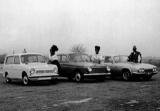



























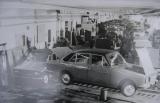
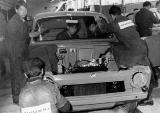

















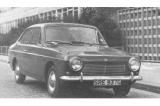







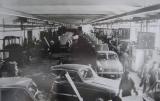


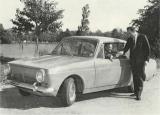
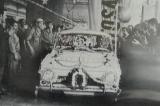

 In 1963, Vehbi Koc and Bernard Nahum have seen a pick-up in front of Otokoc, marketing company of Koc Group. This pick-up was made in Israel (
In 1963, Vehbi Koc and Bernard Nahum have seen a pick-up in front of Otokoc, marketing company of Koc Group. This pick-up was made in Israel (
 A public inquiry has been announced by Otosan to fix the brand name of this new car. More than 2000 brand names have been proposed by approx 100.000 letters. Finaly, "Anadol" name was fixed for the car.
A public inquiry has been announced by Otosan to fix the brand name of this new car. More than 2000 brand names have been proposed by approx 100.000 letters. Finaly, "Anadol" name was fixed for the car. Nahum, head of Koc Automotive Group. Otosan developped an "automatic transmission" version of A1 MkI in 1971 and introduced at Ege Makina showroom in Izmir. This version, called
Nahum, head of Koc Automotive Group. Otosan developped an "automatic transmission" version of A1 MkI in 1971 and introduced at Ege Makina showroom in Izmir. This version, called  Wankel
Wankel In some countries, especiallly in UK, some collectors own Anadols (known as Reliant-Anadol). Reliant have used this cooperation as a good reference and have tried to market the "Anadol Project" to some other countries: Ginea, Australia, India, Malesia, Pakistan, Nigeria, South Africa, Greece, Spain are some those countries. However, this project was always been blocked by the "big" brands. The project was seriously handled by the New Zealand government and some prototypes have been imported in 1967. The brand name was "
In some countries, especiallly in UK, some collectors own Anadols (known as Reliant-Anadol). Reliant have used this cooperation as a good reference and have tried to market the "Anadol Project" to some other countries: Ginea, Australia, India, Malesia, Pakistan, Nigeria, South Africa, Greece, Spain are some those countries. However, this project was always been blocked by the "big" brands. The project was seriously handled by the New Zealand government and some prototypes have been imported in 1967. The brand name was "